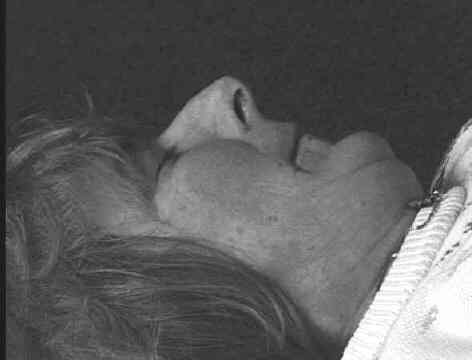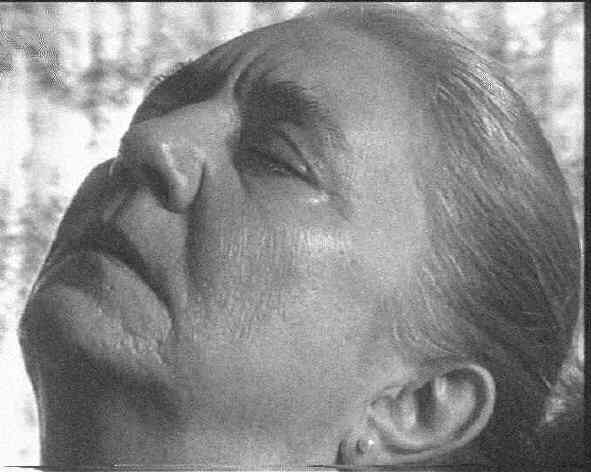
Dancing Silence: Traces
These paragraphs are taken from 'Tentative Approaches: Community Dance and Digital Video Technology.' by Petra Kuppers. Animated Spring 1999: 19-20). The article is reproduced by kind permission of the Foundation for Community Dance. Telephone +44 (0)116 251 0516. Email comdanceinc@easynet.co.uk
|
Traces
|
 |
A large part of my dance work takes place in mental health settings, and my sessions have an emphasis on ‘inner dancing’ – on freeing the mind to imagine different deployments of bodies. I employ relaxation sequences to guide my participants into a state where they can experience dance through visualisation. Through suggestion and deep state relaxation, I guide my participants into dreams: sailing amongst the clouds or waltzing in the wide ballrooms of castles. After the visualisation, we re-capture some of the freedom and imagination of these dream dances in our ‘real’ space and time.
Visualisation, esoteric as it might seem in the context of a dance session, eases the transition between imaginary dance, dream-uses of bodies, into corporeal dance, moving our bodies anew in their everyday environment.
But even before we take to the space, whilst the dancers are lying down and listening to my instructions, their prepared bodies already move and reveal the traces of their inner dances. In my previous work in physical theatre, I have used everyday movement to choreograph dance patterns: but how can I use the microscopic everyday dance of breath under skin as an expressive statement itself?
It is this liminal dance that I am currently investigating: both choreographed and improvised, these traces of movement allow exciting glimpses into the potentials of our bodies.
I got together with Margaret Sharrow, a dancer, screenwriter and film artist with training in digital video work, and we started to challenge what ‘video dance’ could mean for us working in the community. Sharrow’s involvement with bodies and technology includes her latest video project ‘Retrograde’ in which she explores the relationship between scientific concepts and everyday movement. She leads community dance classes in rural Mid Wales from her base in Lampeter, and has made dance and award-winning film work in Canada and Wales. The aesthetic possibilities of making accessible and sensual art works based on small movements excited both of us.
We use the digital video facilities of my work place, the Contemporary Arts Department at Manchester Metropolitan University, to create digital dance videos with our own groups. Our aesthetic guides are Steve Paxton and his ‘small dances’ which led him towards contact improvisation, and contemporary artists such as Susan Kozel, who used technology to create the living presence of the human body in her holographic work ‘Telematic Dreaming’.
|
The Video Installation
|
 |
To see yourself on video can be an affirming experience: it can question your sense of self, or the way you feel your body moving. As a wheelchair using dance leader, I have often used dance videos of CandoCo or Blue Eyed Soul with great success both with non-disabled and disabled workshop participants and audiences. The videos challenge perceptions and stereotypes of dancing bodies in arenas which live dance often cannot reach – small rural community halls or international academic conferences. Starting from this very basic ‘estrangement’ that video can provide, Sharrow and I are currently designing a digital/physical experience of ‘inner dance’ which we can make and use with my community dance groups.
Close-ups can show our bodies as landscapes, new terrains, ready for exploration. Our breath animates these rolling hills, craggy mountains and smooth hollows, and a ‘small dance’ can magically appear on the video screen. But MTV or VH1 have made many people immune to the wonders of the moving body as spectacle: it is so easy to see the endless possibilities of identifying, breathing and moving with the screened dances as so much white noise. We decided to tackle this problem by creating a video installation: a black box, a ‘sensory experience’ which seduces its user.
Our installation consists of 3 black walls, a curtained entrance and a floor covered in cushions, inviting you to sit down and participate. When you enter the black box, you see 3 videos, digitally reworked, two on monitors let into the black walls, and one projected onto a large screen filling the third wall. The videos were shot in our community dance sessions. Traces of our everyday practice prevent our experiment from becoming inaccessible and removed.
The monitors show twitching hands, fluttering feet, breathing chests and eyes following invisible movements under closed eyelids. Digital enhancements add layer and layer of beautiful colour, pixeling away from the familiar bodies into abstraction, and then returning back to them. One monitor maintains a corporeal "real-time": the action is continuous, flowing in synch with the soundtrack on which my voice is heard, fading in and out, giving relaxation instructions and sending participants on dream journeys.
Another monitor shows stills taken out from the familiar action on the first video and held for 60 seconds. The abstract quality of the video is even more apparent in these crystallisations of bodies in motion. Washed with colour, familiar yet strange, even those ‘bits’ deemed unsightly, sagging skin, bellies, or lines are re-valued.
A third image is screened via a video projection onto a large screen. Wherever you are in the black box, sitting, lying or standing up, your shadow merges with the image on the screen. The projection implicates its viewer, who has to move to see the whole picture, or is able to engage in her own dance with the image. We hope that this sound/image/body-scape will elicit positive responses from our groups: our follow-up will include transcribed comments and reactions, pinned to the outside of our black box, making the communal ownership of the project clear.
Widening Access to Creative Expression
Since the social service setting of my work means that we do not engage in performances with these dance groups, ‘Traces’ allows us a different way to create a ‘product’. The video installation creates something that members of the group can take ownership of as their self-expression, which allows them to realise and work on their creative potential. They can take pride in the creative possibilities of their moving bodies without exposing themselves on a stage. Without the elaborate transport problems associated with community dance performances in rural Wales, the installation can be erected in community centres and libraries. Since it does what it shows – working through a relaxation and imaging sequence and showning the effects of imagination on moving bodies – it might help us find new participants for our work, challenging for them what ‘dancing’ can mean.
‘Traces’ is our first step in an ongoing investigation of the uses of new technologies in different community dance environments.